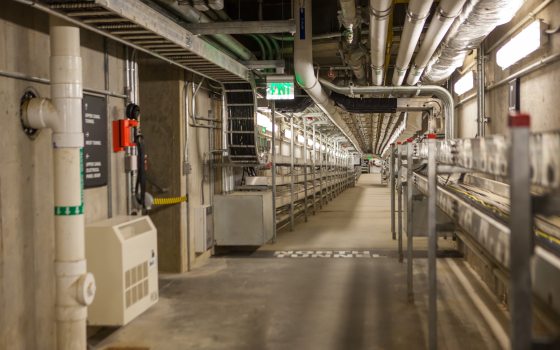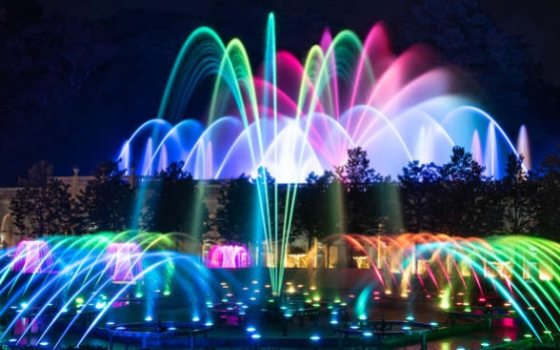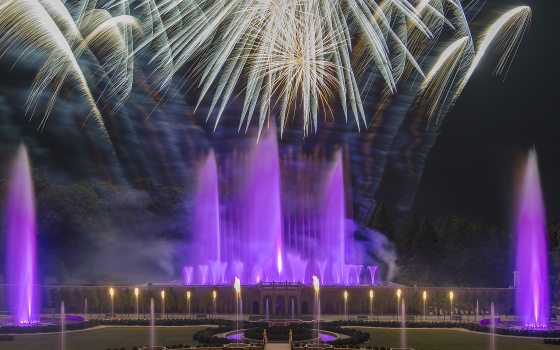Preparing the Main Fountain Garden for its annual awakening is a multi-faceted process of plumbing and electrical ingenuity that begins months before the fountains start to dance, completed to not only allow the Main Fountain Garden to run, but also to give our Performing Arts team ample time to practice before our fountain performances begin.
Plumbing and electrical work is done beneath the surface of the Main Fountain Garden, among the underground pump rooms and 1,400 feet of underground tunnels that together house the garden’s state-of-the-art plumbing and electrical infrastructure. Our work is also done aboveground, readying everything from the 1,719 jets to the 1,700 LED architectural light fixtures, to the 1,389 LED performance lights … to so much more.
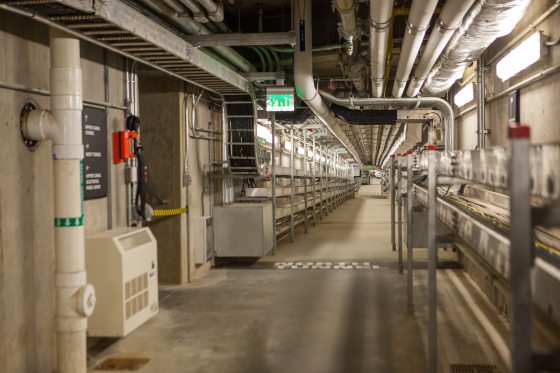
Our underground tunnel system allows access to our plumbing, electrical, and water features for inspection and maintenance. Photo by Morgan Horell.
Each March, we begin our reopening preparations with the sumps, or reservoirs that contain the water used in the fountain displays. After a thorough cleaning and inspection of sump valves, hardware, and waterproofing, and after we prep the chemical feed system for start-up, we begin filling our sumps, continually checking water levels and temperatures using advanced software. It takes a week to fill the sumps, and for good reason … our three underground tanks beneath the basins total 338,000 gallons, while there are also 200,000 gallons stored in the nearby Pear-Shaped Basin for use with the Eye of Water, Waterfall, and Hillside Flume. While that system operates completely separate from the fountains themselves, its pumps are located in the Main Pump Room, beneath the Main Fountain Garden’s Rectangular Basin.
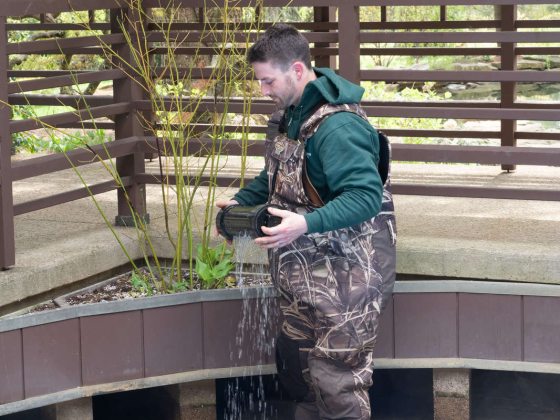
We monitor our water in our Main Fountain Garden and surrounding systems to maintain optimal pH balance, installing chemical treatment capsules as needed, such as this capsule in our Eye of Water, which flows downstream to the Pear-Shaped Basin. Photo by Bill Hill.
A total of 68 display and filtration pumps that power the nozzles are located throughout the Main Pump Room and three other pump rooms. For the most part, one pump powers one robotic nozzle (there are a few pumps that supply two displays through valve switching). Without them, our fountains couldn’t perform, much less soar to heights of up to 175 feet.
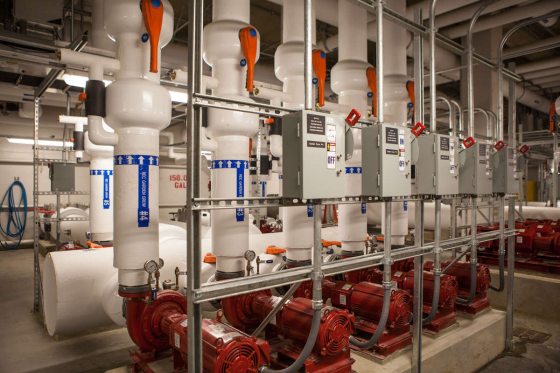
Our Main Pump Room, located underneath the Rectangular Basin, houses a series of pumps that power the robotic nozzles. Photo by Morgan Horell.
Our 1,719 Main Fountain Garden jets, which include 379 legacy jets and 1,340 new jets, must be meticulously inspected and prepared before the start of the season. We remove each robotic nozzle at the conclusion of the prior season in order to protect them from freezing during the winter months. Come spring, after inspecting all nozzles, we then install the nozzles for all of our “Garden Grow” spinning nozzles (there are 14 of these in the Rectangular Basin and one in each Round Basin); our eight “Hidden Layer Dancer” one-axis nozzles that move east to west; our 11 “Dancer on a Stage” two-axis nozzles that can move in any direction; and 32 Titan air nozzles that blast five gallons of water each.
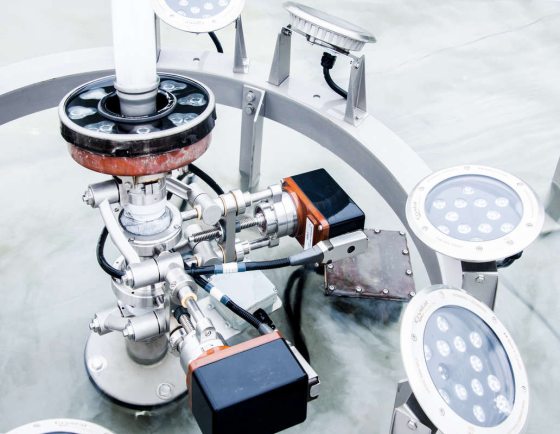
A close view of a “Dancer on a Stage” two-axis nozzle shows the marriage of plumbing and electrical work necessary to make it, well, dance. Two motors tilt the central nozzle on an x- and y-axis. Four lights shine inward and four shine outward, while a light fixture encircling the nozzle moves with it for continuous illumination. Photo by Bill Hill.
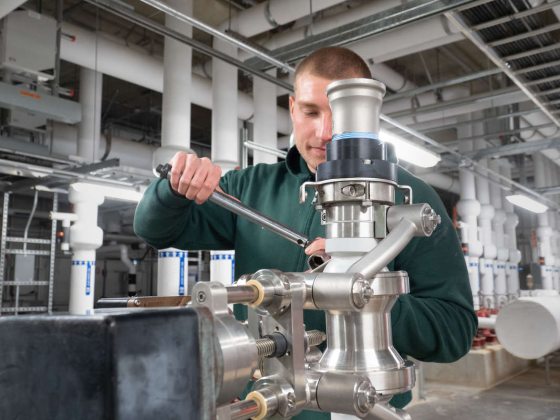
Our nozzles, including this two-axis Dancer on a Stage, must operate at a just-so level, right down to the torque determined by the tightening of their bolts. Photo by Bill Hill.
We place all valves in proper position for operation and test them, as well as test every bit of hardware throughout the system. We also place extremely heavy stones (weighing in at 150 pounds per cubic foot) over the troughs in the Rectangular Basin to cover the Titans and make a neater looking display. The buoyancy and pounding of water falling on the stones can make them move, despite their weight, so the pins sticking up out of the metal cross beams help hold the stones in place.

Stones in the Titan trough are held in place by pins in the metal cross beams, as shown on the left side of this picture. Photo by Bill Hill.
The troughs themselves must also be manually cleaned and inspected, as do the leaf and sediment strainers, which are located on every single pump underground and in each of our 29 octagon wellheads in the Main Fountain Garden.
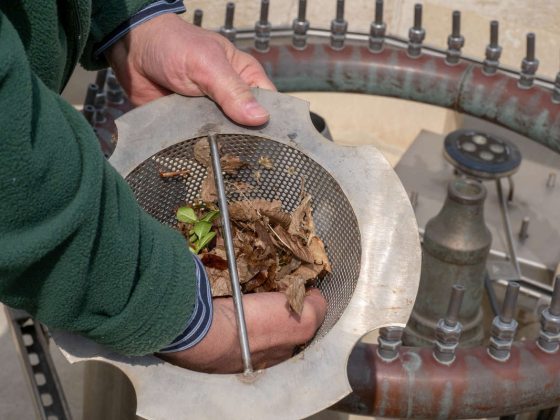
Each of the strainers in the octagons must be manually inspected and cleaned throughout the performance season. Photo by Bill Hill.
Our large leaf catcher, which is housed underground and filters leaves and sediment from the Pear-Shaped Basin and Eye of Water, must also be inspected and maintained as necessary. Simply put, our system must be clean of any debris in order to run.
Without electricity and our electricians, the water is unable to move. As there are a total of 1,389 LED lights in the Main Fountain Garden, there are 140 control boxes with breakers, wire connections, and power supplies that need to be checked and maintained. Our electricians test all 140 control boxes and their electrical connections to make sure we can successfully program light channels, which communicate with our Navigator infrastructure software, which then communicates with our Syncronorm performance software. Our electrical connection boxes are located in the pump rooms and throughout our underground city of tunnels; each can control up to 16 performance lights.
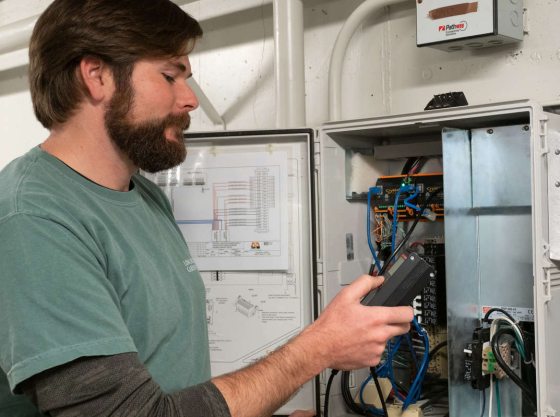
Each control box communicates with our infrastructure and performance software. Photo by Bill Hill.
Our electricians also confirm breaker and load associations, test all wiring, and make electrical connections on our 30 flame feature jets that appear atop the Upper and Lower Canal jets, essentially rebuilding those flame feature connections each year.
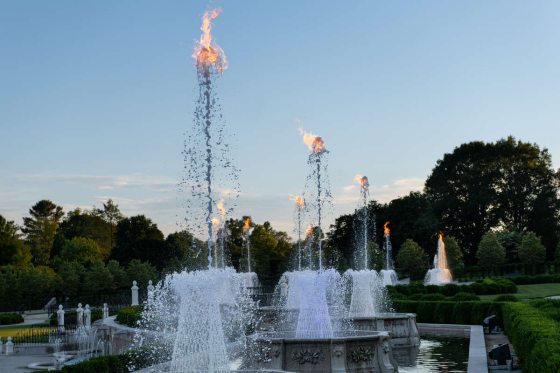
Our flame features in all their glory. Photo by Hank Davis.
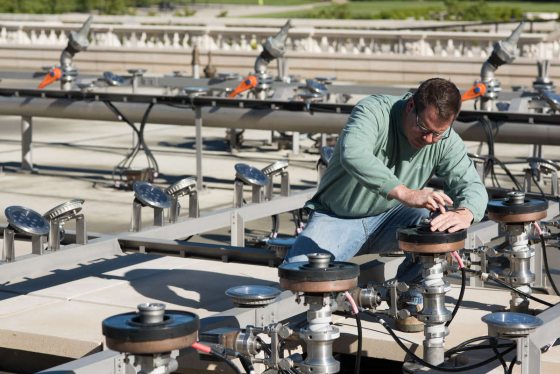
We test every single nozzle to make sure they’re operative once they’re installed. Without this work, our fountains couldn’t spin, undulate, or soar. Photo by Hank Davis.
It’s a long to-do list with many more items than we’ve described here. It’s also one that is never fully complete, in a sense. We’re constantly checking and rechecking all systems throughout the months our Main Fountain Garden performs and the months it doesn’t perform, getting the garden ready for the winter, followed by waking it up all over again. Of course, this is all done for the love of the performance, the delight of our guests, and the reverence for the great legacy and magic of our spectacular Main Fountain Garden.
